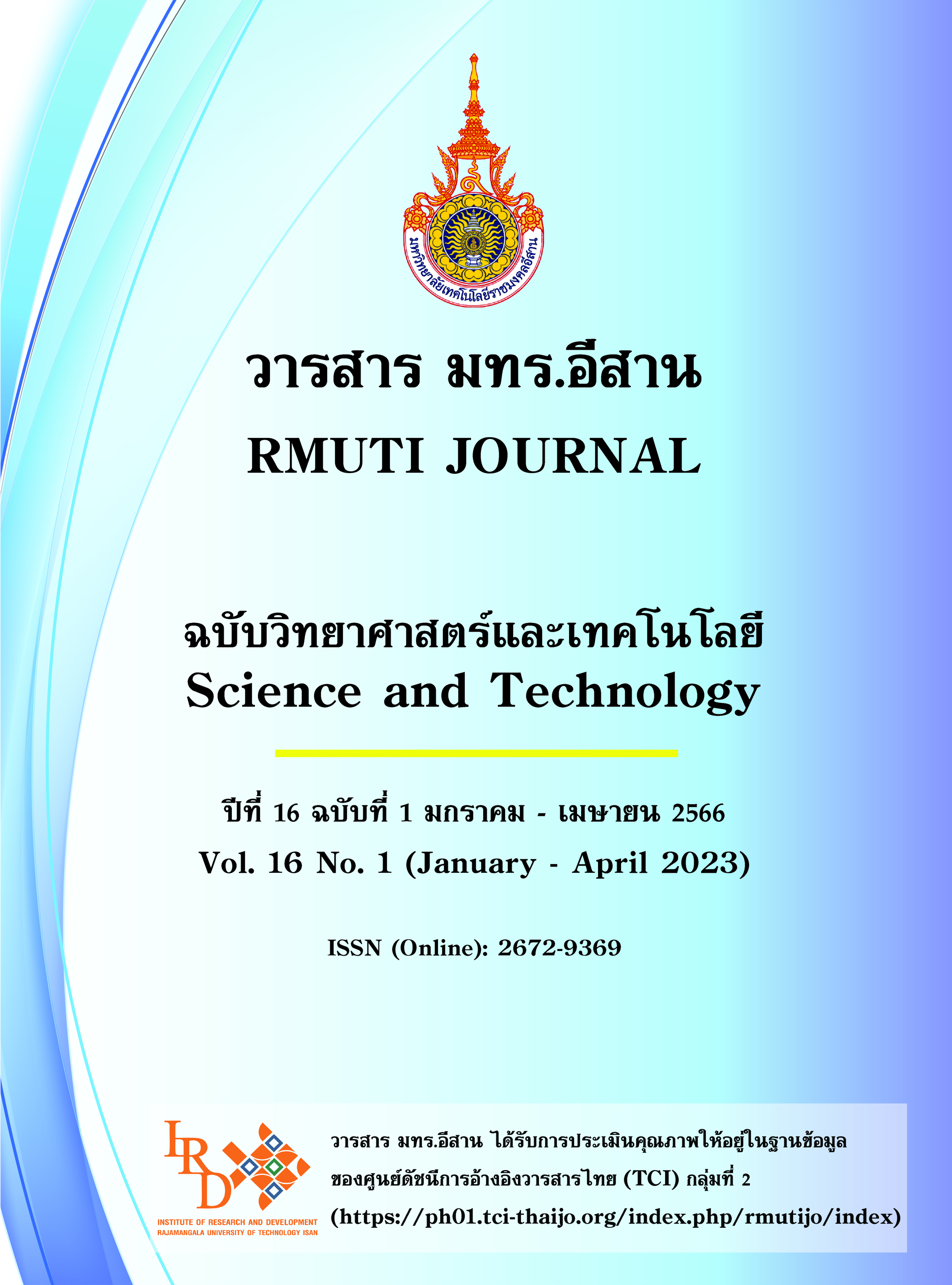Properties of Concrete Mixed with Recycled Crumb Rubber-Tires
Main Article Content
Abstract
The objective of this paper was to study the physical and mechanical properties of concrete mixed with recycled crumb rubber-tires. The density, water absorption, compressive strength, tensile strength, bending strength, modulus of elasticity and modulus of rupture were tested. This study replaced sand with crumb rubber-tires in the ratios of 5, 10, 15 and 20 percent by weight. The results revealed that the density, water absorption, compressive strength, tensile strength, bending strength, modulus of elasticity and modulus of rupture of concrete mixed with recycled crumb rubber-tires decreased with an increase in the amount of crumb rubber-tires. However, the reduction in density and water absorption showed that concrete was lighter and more impermeable. In addition, the concrete had an increased maximum deflection before failure and the modulus of elasticity obtained by the test was about 60-70 percent different from the calculation.
Article Details

This work is licensed under a Creative Commons Attribution-NonCommercial-NoDerivatives 4.0 International License.
References
Institute of Plastics. (2014). Rubber Particles. Access (1 April 2022). Available (http://rubber.oie.go.th/ ELibrary.aspx?cid=75)
Budnumpetch, T. and Tanpaiboonkul, N. (2016). Properties of Lightweight Concrete Containing Crumb Rubber and Cement Replacing with Fly Ash from Coal Power Plant. Veridian E-Journal, Science and Technology Silpakorn University. Vol. 3, No. 4, pp. 62-75. (in Thai)
Chaikaew, C. (2004). Study on The Use of Wasted Tire Particles on Soft Surface Concrete Paving Block. In 4th International Conference on Concrete under Severe Conditions: Environment and Loading (CONSEC04). Korea: Seoul National University
Duangseang, C. and Kiatwongtong, S. (1998). Mechanical Properties Study of Concrete Using Tire Particles as Ingredient. Institute for the Promotion of Teaching Science and Technology. Access (1 December 2021). Available (https://uatscimath.ipst.ac.th/2021/project-computer/item/6404-2016-09-09-03-49-35-6404)
Intaboot, N. and Kanbua, P. (2021). Investigation of Concrete Blocks Mixed with Recycled Crumb Rubber: A Case Study in Thailand. Engineering and Applied Science Research. Vol. 49, No. 3, pp. 413-424. DOI: 10.14456/easr.2022.42
ASTM C642. (1997). Standard Test Method for Density, Absorption, and Voids in Hardened Concrete. Annual Book of ASTM Standard. Vol.04.02.
ASTM C39. (2021). Standard Test Method for Compressive Strength of Cylindrical Concrete Specimens. Annual Book of ASTM Standard. Vol.04.02.
ASTM C496. (1996). Standard Test Method for Splitting Tensile Strength of Cylindrical Concrete Specimens. Annual Book of ASTM Standard. Vol.04.02.
ASTM C469. (2014). Standard Test Method for Static Modulus of Elasticity and Poisson’s Ratio of Concrete in Compression. Annual Book of ASTM Standard. Vol.04.02.
ASTM C78. (1994). Standard Test Method for Flexural Strength of Concrete (Using Simple Beam with Third-Point Loading). Annual Book of ASTM Standard. Vol.04.02.
Pangdaeng, S., Ngamtavee, S., Tho-in, T., Hanjitsuwan, S., and Phoo-ngernkham, T. (2021). Mechanical Properties of Fly Ash Geopolymer Concrete Incorporating Clay Residue and Silica Fume. RMUTI JOURNAL Science and Technology. Vol. 15, No. 2, pp. 1-10 (in Thai)
Karnjana worawanit, B. (2004). Tires. Article of National Metal and Materials Technology Center. Access (6 November 2022). Available (https://www2.mtec.or.th/th/e-magazine/admin/upload/ 214_20-24.pdf)
Khaloo, A. R., Dehestani, M., and Rahmatabadi, P. (2008). Mechanical Properties of Concrete Containing a High Volume of Tire-Rubber Particles. Waste Management. Vol. 28, Issue 12, pp. 2472-2482. DOI: 10.1016/j.wasman.2008.01.015
Eldin, N. N. and Senouci, A. B. (1993). Rubber-Tire Particles as Concrete Aggregates. American Society of Civil Engineers. Vol. 5, Issue 4, pp. 478-496
Miah, M. J., Babafemi, A. J., Paul, S. C., Kong, S. Y., Li, Y., and Jang, J. G. (2022). Eco-Friendly Concrete with Chemically Treated End-of-Life Tires: Mechanical Strength, Shrinkage and Flexural Performance of RC Beams. Construction and Building Materials. Vol. 351, p. 128970. DOI: 10.1016/j.conbuildmat.2022.128970
Jiravacharadet, M. (2014). Reinforced Concrete Design (Strength Design Method). Nakhon Ratchasima: Suranaree University of Technology. pp. 4-5
Seangatith, S. (2013). Mechanical Properties of Polyester Polymer Concrete under Compressive and Flexural Loads. Research Reports. Access (25 December 2022). Available (https://http://sutir.sut.ac.th:8080/sutir/bitstream/123456789/5415/2/Fulltext.pdf)
Hanjitsuwan, S., Tho-in, T., and Phoo-ngernkham, T. (2021). Influence of NaOH Concentration and Sand to Binder Ratio on Hybrid Cement Mortar for Filled Materials in Notched Concrete Beam. RMUTI JOURNAL Science and Technology. Vol. 15, No. 1, pp. 1-10 (in Thai)


